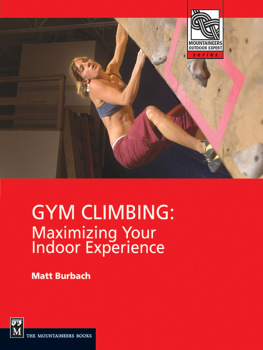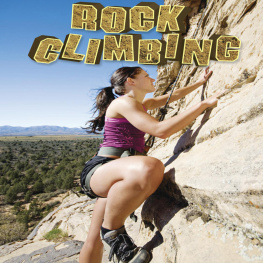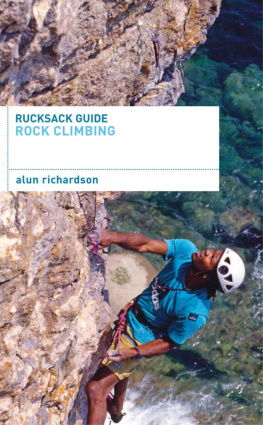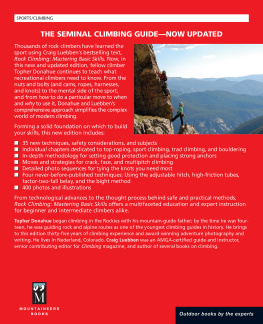The content in this book is made up mostly of blogposts that I wrote over the course of a couple of years for a now defunctclimbing blog. The tips are loosely sorted into categories, and each tip is itsown bite-sized chunk of climbing knowledge.
Ive been climbing for more than 18 years and haveestablished around 200 new routes. The tips in this book come straight from myyears of experience. Beginning climbers will find a lot of information herethat will make their climbing lives a lot easier. Even if youre an experiencedclimber, I expect youll find some tips here that you havent heard or seenbefore.
If youd like to tell me how much you loved or hatedthe bookor if you have any other questions, comments, orsuggestionsfeel free to contact me. I tweet about climbing news and tipsat .
1. 3 Toproping Tips for Aspiring Leaders
I went climbing with a couple of relatively inexperiencedfriends not too long ago. Theyve both led before, but theyre still in thatstage where they toprope a lot. As I watched them toprope some climbs, severalpointers came to mind. Below are the tips that I would give to aspiring orbeginning leaders to help them get a more realistic idea of what to expect whenleading.
1. Pay attention to where the bolts are When youre leading, you climb where the bolts are. Its easy whentoproping to deviate from the line of the route into easier or harder (ormore dangerous) terrain. When on toprope, try to always stay within arms reachof the bolts.
2. Remember the consequences of falling Falling on toprope is not a big deal. At all. The rope stretches a bit,or you might take a swing if youre climbing too far off to the side, but thatsit. When lead climbing, there are times when you just do not fall.Maybe youre above inadequate gear, or maybe theres a ledge below you that youllbreak your ankles on if you fall. When on toprope, be sure that youre aware ofwhats around you. Think to yourself, OK, if I were leading this, I really,really wouldnt want to fall here.
3. Practice clipping or placing gear Letting go with one hand to clip a bolt or place a cam definitely makes leadingharder. Its an important element that is missing when toproping. If youreTRing a sport route, think about where youd clip from and then pretend to clip.One common practice is to simply touch the bolt hanger for a second. No, itsnot the same as reaching down, unclipping a quickdraw from your harness,bringing it up, clipping it into the bolt, reaching down for the rope, bringingit up, and clipping it into the draw (phew!), but at least its something. Ifyou want a more realistic version, take quickdraws up with you and practiceclipping.
Another option is to have the leader leave the drawsclipped into the bolts so that you have to unclip them as you climb up ontoprope. If youre on a single-pitch trad route, you can do the same thing;that is, you can have the leader leave his/her pieces of gear in the crack foryou to remove as you climb up. Or you can just mentally note where and when youdplace the pieces. Its also useful to examine each gear placement, figure outwhy the leader placed it there, and assess whether its a good placement.
2. Dont Put Your Leg in Front of the Rope When Leading
Youre on a desperate lead and fighting to stay on.Youre trying to get your fingers to close but your forearms are absolutelydestroyed. You half-heartedly lunge for a hold, knowing that youll probablytake a fall. You start to drop. All of a sudden youre upside down. Youvesmacked your head on the wall and youre seeing stars. What happened?
The likely culprit? Your foot got in front of therope. Figure 1 shows what Im talking about (its a view of the back of theclimber).

Figure 1. The rope is behind the climbers rightleg. Not good.
Note that the rope is behind the climbers right leg.Go through in your head what would happen if this climber were to fall. Insteadof falling normally, the rope going behind his leg would flip him upside down. Keepyour leg behind the rope to avoid this scenario.
This is still something that even more advancedclimbers struggle with from time to time. One way to get out of the bad habit (orany bad climbing habit, really) is for you and your partners to watch eachother and call each other out when you see the dirty deed.
3. Should You Practice Falling?
Should beginning climbers take time to practicefalling? Will this help them build confidence and overcome fear?
I think it really depends on each climberindividually. Most beginning leaders have a healthy fear of falling, and thatsnatural. The question is, just how scared are you? If the idea offalling absolutely paralyzes you and keeps you from climbing anything evenslightly above your comfort zone, then yes, I would recommend that you practicefalling.
At first, just clip into a bolt and have your belayertake in all the slack. Let go so that youre supported by the rope. Then climba little bit higher and let go. To be honest, Ive never done any falling justfor the sake of falling (my first falls just came naturally from sucking atclimbing and being overly ambitious), so itll be up to you to determine whereyour comfort zone is and how long of falls you are willing to take.
If you are going to practice falling, make sure youwont hit any ledges or other objects on your way down and that all falls willbe clean. Vertical or overhanging walls are best for this unless you relishthat cheese-grater-on-your-hands feeling.
If you havent taken any falls because you lackclimbing experience rather than having some kind of paralyzing fear, then Idsay just keep climbing. Youll fall eventually. If youve climbed up to 5.9 andhavent taken any falls, get on a 5.10. Youll either fall and realize thatfalling is not too bad, or youll waltz right up the thing. Either way, it willbe a good experience, right?
I have two more thoughts on this. First, if you dontwant to fall, then dont! If you really are scared of falling and are happy onthe routes you currently can send without falling, more power to you. Climbingis your game, and if youre happy the way you do it, dont let anyone tell youdifferent. But that brings me to the second thought, and that is to keep inmind that falling really isnt too bad. Most of the time its over before you evenrealize whats happening. The more you do it, the easier it gets.
Overall, I would recommend getting used to falling.Whether that entails actively practicing it or just falling from being on stuffthats too hard for you to climb is your prerogative. When youre not scaredout of your gourd, youll find it easier to focus on the climbing itself, andthe whole experience becomes more enjoyable







